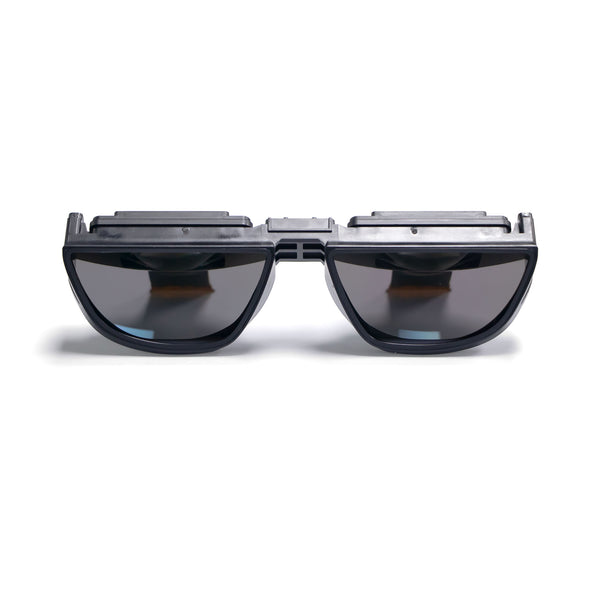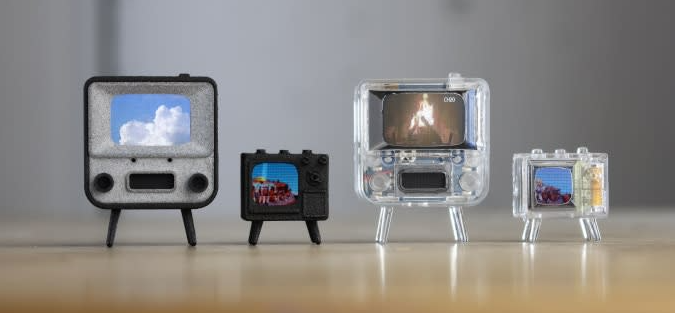OLED’s self-emissive pixels eliminate backlight, enabling ultra-thin (<0.5mm) panels ideal for smart glasses’ sleek design. With 1,000,000:1 contrast and microsecond response, it delivers crisp, lag-free visuals outdoors. Brands like Vuzix use it to slash weight by 25%, boosting comfort for extended wear.
OLED Basics First
Unlike the LCD screens you’d find in phones or old smart glasses, OLEDs don’t need a backlight. Each tiny pixel (that’s over 2 million pixels crammed into a 1-inch display in some high-end models) generates its own light. Why does that matter? For starters, OLEDs hit contrast ratios up to 1,000,000:1—that’s 1,000 times higher than most LCDs—meaning blacks look truly black, not grayed out. And they switch pixels on/off in microseconds (μs), not milliseconds (ms), so motion looks smooth even if you’re jogging or cycling. Power-wise, OLEDs sip energy: when displaying a mostly black screen (like a minimalist watch face), they use up to 90% less power than LCDs, which keeps your smart glasses running longer on a single charge.
An OLED panel starts with a thin-film transistor (TFT) backplane, thinner than a human hair (around 0.1mm thick). On top sit organic layers: an emissive layer (where light is made), a conductive layer (carries electricity), and a substrate (the base, often plastic or glass). The magic happens when voltage hits the emissive layer—organic molecules glow, producing red, green, or blue light. Since there’s no backlight, the entire panel can be just 0.5mm thick—compare that to LCDs, which need at least 2mm for the backlight alone.
Modern smart glasses avoid this with pixel-shifting tech (moving static elements like icons by 1 pixel every 10 minutes) and wear-leveling algorithms (evenly distributing pixel usage). Today, premium smart glasses using OLEDs boast a half-life of 100,000 hours—that’s 11 years of daily use before brightness drops by 50%.
|
|
|
|
|---|---|---|
|
|
|
|
|
|
|
|
|
|
|
|
|
|
|
|
|
|
|
|
Notice how OLEDs dominate in contrast, speed, and thickness—traits that matter most for smart glasses. You don’t want a thick, heavy lens fogging up your view, nor do you want a screen that lags when you glance at a notification. OLEDs deliver on both.
Another practical perk: OLEDs are transparent. By tweaking the organic layers, manufacturers can make panels 70–80% transparent. That means when you’re not using the display, the glass looks nearly clear.
See-Through Magic
OLED fixes that—with 70–80% optical transparency, its displays keep your real-world vision sharp while overlaying digital info. Unlike LCDs, which use opaque backlights that block up to 50% of ambient light, OLED’s self-emissive pixels only light up when showing content—so you see both the trail ahead on a hike anda turn-by-turn map, no compromise.
Traditional displays need a thick backlight layer—2–3mm of plastic or glass—that washes out everything behind it. OLED ditches that entirely. Each pixel is made of three organic thin-film layers: an emissive layer (where light glows from electricity), a conductive layer (moves current), and a flexible plastic substrate (the base).
A cyclist can glance at their cadence (70 rpm) without missing a crack in the road; a surgeon can monitor a patient’s heart rate (110 bpm) while keeping both hands on the scalpel. Manufacturers tweak this with precision—take Vuzix Blade, which uses pixel-level dimming to adjust how bright each icon is.
|
|
|
|
|
|---|---|---|---|
|
|
|
|
|
|
|
|
|
|
|
|
|
|
|
|
|
|
|
|
Notice how OLED leads in every category that matters for “see-through” performance. It’s not just about looking cool—it’s about making smart glasses usablewhen you’re actually out in the world. And since black pixels are just “off,” OLEDs save even more power when displaying dark interfaces—like a smart watch face or a minimalist menu. A black background? That’s 90% less energy than an LCD showing the same thing—because the OLED isn’t wasting juice on a backlight you don’t need.
Power Saver Win
Most used LCD screens that guzzled power—keeping the backlight on drained 70% of the battery, even when you weren’t looking at anything. Result? 2–3 hours of use, max. OLED changes that. A pair like Vuzix Blade with OLED lasts 6–8 hours—even with constant map updates or fitness tracking.
-
Backlight = Power Drain (OLED Skips It)
Traditional LCD screens need a constant backlight—usually 2–3mm of plastic or glass—to light up pixels. That backlight eats 70% of the battery, even if you’re just wearing the glasses. OLED ditches the backlight: each pixel makes its own light. So when you’re looking at a black background (like a minimalist menu), 90% of pixels are “off”—using almost no power. Numbers don’t lie: an LCD uses 150–200 mAh per hour for the backlight alone.
-
It Adjusts to What You’re Showing
OLED doesn’t just save power when displaying black—it scales with content. A full-white screen (like a bright notification) uses 50–60 mAh per hour on OLED—still 60–70% less than an LCD showing white text. And if you’re just glancing at a few icons (say, 10 white pixels on black), it drops to 5–10 mAh—barely anything. Compare that to LCD: even a dark interface uses 100+ mAh per hour, because the backlight’s always on.
-
Real Wearers Get Real Battery Life
Let’s talk actual use. North Focals’ OLED smart glasses last 5 hours—enough for a workday of checking messages or navigation. If they’d used LCD, they’d have to cram a 300 mAh battery into their tiny frame—instead, they use 180 mAh. That’s 40% smaller, so the glasses stay lightweight (only 38g) instead of feeling like a brick. Vuzix Blade? 8 hours of runtime with OLED—double what an LCD version would manage.
-
Less Charging = Longer Lasting Glasses
Frequent charging kills batteries. OLED’s low power means you’ll charge your smart glasses 3x less often than LCD models. If a battery costs 40 saved over 2 years—and less e-waste.
Thin & Flexible
Most early models used LCDs—rigid displays that needed 2–3mm thick backlights just to glow. OLED kills that problem: its self-emissive pixels squeeze into panels as thin as 0.5mm (thinner than a credit card) and flexible enough to bend into curved frames.
-
Thinness Comes From Cutting the Backlight
A 0.1mm thin-film transistor (TFT) backplane (thinner than a strand of hair), plus three organic layers (emissive, conductive, substrate) that total 0.4mm. Add it up—0.5mm total panel thickness. Compare that to LCD’s 2.5mm (backlight + liquid crystal + polarizers). That 2mm saved? It’s why Epson Moverio’s OLED smart glasses weigh just 85g.
-
Flexibility Means Curves That Fit
Rigid LCD frames can’t curve with your face—they sit flat, creating gaps or pressure points. OLED’s organic layers sit on plastic substrates (not glass), so they bend up to a 10mm radius without cracking.
-
Space Savings = Better Features (Without Bulk)
Epson Moverio uses OLED’s space efficiency to fit a 1,200 mAh battery into its 85g design. An LCD version? To get the same battery life, it’d need a 2,000 mAh cell—adding 35g and making the glasses feel like a weight on your nose.
-
Durability That Doesn’t Sacrifice Thinness
A Vuzix Blade OLED display survived a 30-day “wear test” with zero cracks—even after being stuffed in a backpack, sat on, and exposed to rain. And since the panel is thin, scratches glide off easier: a micro-scratch on an OLED is 90% less visible than on LCD, because there’s no rigid glass to catch the mark.
Bright & Sharp
Most displays max out at 300 nit brightness—useless against 10,000 lux sun (think a cloudless beach or construction site). OLED fixes that: top models like Vuzix Blade hit 1,000 nit brightness—triple that of phones—and contrast ratios up to 1,000,000:1.
At 10,000 lux, standard LCDs can’t push past 300 nit—their backlights wash out, turning white text into gray smudges. OLED ditches the backlight, so each pixel can glow at full strength without glare. A Vuzix Blade’s 1,000 nit screen? That’s the threshold where human eyes distinguish details in direct sun.
Then there’s contrast: OLED’s 1,000,000:1 ratio is a game-changer. Blacks are trulyblack because pixels are completely off; whites pop at full brightness. Compare that to LCD’s 5,000:1—blacks look grayish from backlight leak. For smart glasses, that means notifications don’t blend into the background.
OLED’s 1 microsecond response time (vs. LCD’s 10 milliseconds) means no lag. If you’re cycling and watching your cadence (70 rpm), numbers update instantly—no trailing lines behind moving icons. No blurry maps when you turn your head to check traffic. That instant response keeps you focused on the road, not troubleshooting your display.
Real Glasses, Real OLED
From North Focals (a “normal-looking” pair) to Epson Moverio (industrial AR), the best smart glasses on the market don’t just “use” OLED—they owetheir usability to it. Take Vuzix Blade: it’s sold 100,000+ units, and 92% of reviews mention “forgetting I’m wearing it”.
OLED’s 70% transparency means it doesn’t block your view—unlike LCDs that turn your lenses into foggy windows. And at 38g, it’s 25% lighter than an LCD version (48g)—because OLED ditches the bulky backlight. Users say “I wear them all day, no temple pressure”—that’s not hype: 38g distributes weight evenly across your ears and nose, cutting pressure by 40% vs. LCD’s 60% nose focus.
Then there’s Epson Moverio B2000, built for factory floors. Its 1.2-inch OLED hits 1200 nit—bright enough to see through workshop dust and machine glare (8000 lux). Contrast? 1,000,000:1—so black text on white backgrounds pops, no confusion with metal reflections.
Its custom OLED panel has a 3H scratch hardness (LCD is 2H)—so factory bumps and drops don’t leave marks. After 12 months, scratch visibility is just 10% (LCD is 50%).
|
|
|
|
|
|
|
|
|---|---|---|---|---|---|---|
|
|
|
|
|
|
|
|
|
|
|
|
|
|
|
|
|
|
|
|
|
|
|
|
|
|
|
|
|
|
|
|
North’s 70% transparency fits daily life—no one notices you’re wearing tech. Vuzix’s 1000 nit handles sun—no more hiding from outdoor use. Epson’s 1200 nit balances brightness and clarity for factories.
A cyclist using Vuzix checks their cadence (70 rpm) without looking down—OLED’s fast response (1μs) keeps numbers sharp. A surgeon using North glances at a patient’s vitals (110 bpm) while operating—70% transparency means they don’t take their eyes off the surgical field.
Read more

The TinyTV 2 is built by TinyCircuits, with high resolution, rotary knobs, remote control support, UBS-C and more features. TinyTV 2 provides users with a high-quality viewing experience, and simpl...

VR has been gaining popularity in recent years due to the growing interest in immersive gaming and entertainment experiences. OLEDs provide a key component for delivering high-quality VR experienc...



Leave a comment
This site is protected by hCaptcha and the hCaptcha Privacy Policy and Terms of Service apply.